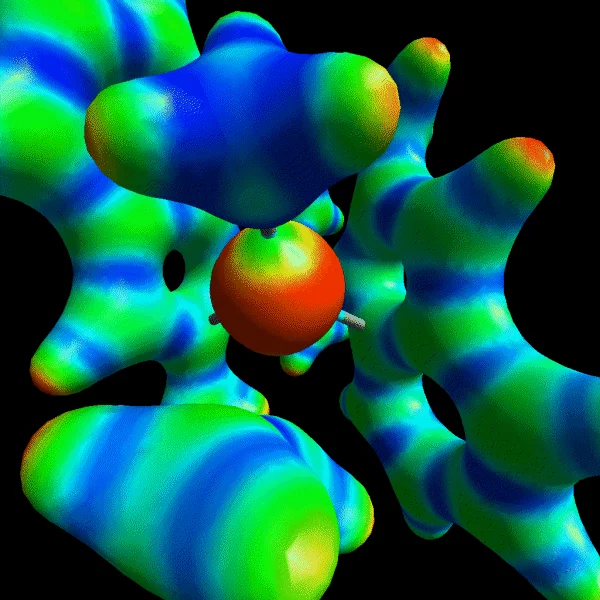DMol3
Figure 1 shows the interaction of ethylene with a zirconocene catalyst. DMol3 is particularly suited for the study of such transition metal compounds and their reactions.
- State of the art density functional code for molecules, surfaces, and crystals with highly efficient numerical basis
- Applicable to all types of molecular systems, insulating crystals, and surfaces
- Successful applications to organic chemistry, organometallics, zeolites, oxide surfaces, polymerization catalysis, molecular crystals, and chemical vapor deposition
- Calculation methods include:
- Self-consistent DFT for closed and open shell systems
- DFT calculations for crystals and surfaces with adsorbates
- Local DFT functionals: PWC, VMN, JMW & KS
- GGA DFT functionals: PW91, BLYP, BP, PBE and more
- Optional relativistic corrections
- All-electron or semilocal pseudopotentials
- Tetrahedron method for k-space integrations in metallic solids
- Capabilities include:
- Energies and binding energies
- Structural optimizations
- Vibrational frequencies/IR absorption, example: rocksalt vibrations
- Constrained optimizations
- Transition state searching
- Intrinsic reaction coordinate (IRC) finding
- DFT-MD with thermostats
- Polarizabilities
- Dipole moments
- Partial charges with Mulliken or Hirshfeld analysis
- Display of orbitals, densities, and potential
- Mayer bond orders
- Thermochemical properties
- Nuclear electric field gradients
- Densities of states
- Bandstructure plots (also with band-population analysis)
- Fermi surface
- Tersoff-Hamann surfaces for tunnel microscopy
- COSMO model for molecules and surfaces: interfaces at liquids
- UV + visible spectra: TDDFT
Contact
- Dr. Bernard Delley (DMol3 developer, especially quantum part)
Further information
- DMol3 publications at accelrys
- DMol3 collaborators page
- More information and commercially available DMol versions: DMol3-mstudio
- NOMAD uploads
FAST – Generation-IV nuclear reactors with a fast neutron spectrum
FAST is an R&D project on-going at PSI since 2002 and the current goals are
- to study neutronics, thermal hydraulics and fuel behaviour of advanced fast-spectrum nuclear reactors using modern computational tools (TRACE/PARCS/FRED, Eranos/EQL3D, Serpent 2, OpenFOAM);
- to evaluate safety of fast reactors considered for construction in Europe (in particular, ASTRID SFR);
- to analyse innovative design solutions for Generation-IV Molten Salt Reactor;
- to represent Switzerland internationally (in GIF, IAEA, OECD, EURATOM);
- to educate young researchers and students (in particular, via the ETHZ/EPFL Master of Science in Nuclear Engineering and EPFL PhD programs).
The cross-cutting topics are equilibrium fuel cycle, transient analysis, and validation of the codes, using available experimental data.
Homepage FAST project
OPAL – An Object oriented Parallel Accelerator Library
OPAL is an open source C++ framework for general particle accelerator simulations including 3D space charge, short range wake fields and particle matter interaction. OPAL is based on IPPL (Independent Parallel Particle Layer) which adds parallel capabilities. Main functions inherited from IPPL are: structured rectangular grids, fields, parallel FFT and particles with the respective interpolation operators. Other features are, expression templates and massive parallelism (up to 65000 processors) which makes it possible to tackle the largest problems in the field. A new Trilinos based iterative solver - currently in the commissioning phase - handles arbitrary complex boundary conditions and benefiting from the new geometry class.
Homepage OPAL project
PSI-BOIL – In-house CFD code
We are developing an in-house Computational Fluid Dynamics (CFD) code PSI-BOIL (Parallel SImulator of BOILing phenomena) since 2006. The main purpose of the code is basic research of new models for turbulence, multi-phase flows, with interface tracking and particle tracking, and phase change. Numerical models developed by using PSI-BOIL are a conservative two-phase flow model, bubbly flow model using coarse grid, a modelling for wetting phenomena, phase change models based on a sharp interface and a phase field approach, and an immersed boundary method. As applications of the code, Large Eddy Simulation (LES) of muptiple impinging jets, boiling flows, etc. have been published. The code is parallelized with MPI, running on normal cluster computers and a supercomputer Piz Daint at Swiss National Supercomputing Center.
Homepage PSI-BOIL project
QTC@PSI – Quantum Technology Collaboration at PSI
The CMT group of LSM is a member of the Quantum Technology Collaboration at PSI
Homepage QTC@PSI project
multiX – Modelling of XAS and RIXS spectra
For background please look up and cite:
A. Uldry, F. Vernay, and B. Delley
Systematic computation of crystal-field multiplets for x-ray core spectroscopies
Phys. Rev. B 85, 125133 (2012)
DOI: 10.1103/PhysRevB.85.125133 (DORA link)


